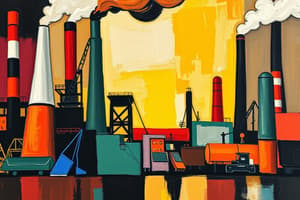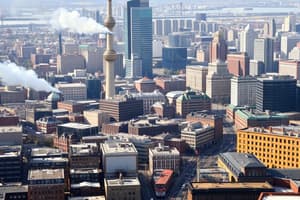Podcast
Questions and Answers
What factors contributed to the low wages of American workers during the Second Industrial Revolution?
What factors contributed to the low wages of American workers during the Second Industrial Revolution?
- The influx of unskilled labor from immigrants, women, and children (correct)
- Government-mandated wage increases
- The establishment of minimum wage laws
- High demand for skilled workers
Which event highlighted the dangerous working conditions of factories during this period?
Which event highlighted the dangerous working conditions of factories during this period?
- The Great Depression
- The Triangle Shirtwaist Factory fire (correct)
- The San Francisco earthquake
- The Fire of Chicago
How did the workplace conditions in factories during this time period typically compare to modern standards?
How did the workplace conditions in factories during this time period typically compare to modern standards?
- Safer, with better wages
- More dangerous, with a higher accidental death rate (correct)
- More regulations, with enforced breaks
- Similar in danger, but with better insurance options
What was one significant result of the labor movement during the Second Industrial Revolution?
What was one significant result of the labor movement during the Second Industrial Revolution?
What was the average workweek for American men during the Second Industrial Revolution?
What was the average workweek for American men during the Second Industrial Revolution?
Flashcards are hidden until you start studying
Study Notes
Economic Transformation
- The Second Industrial Revolution occurred between the Civil War and World War I, shifting the economy focus to factory production.
- Factories heavily relied on unskilled labor, filled predominantly by immigrants, women, and children.
Labor Conditions
- Workers, particularly American men, earned poverty wages without a minimum wage despite lengthy 60-hour work weeks and no paid holidays.
- The workplace was hazardous, exhibiting an accidental death rate nearly eight times higher than contemporary standards.
- Lack of disability payments left injured workers without support, worsening their economic plight.
Notable Events
- The 1911 Triangle Shirtwaist Factory fire resulted in 146 fatalities, spurring the introduction of workplace fire safety regulations.
Labor Movements
- Formation of labor unions emerged as a response to exploitative working conditions, advocating for better rights and safety measures.
Social Changes
- Over time, child labor rates decreased, leading to new opportunities emerging in white-collar professions.
Studying That Suits You
Use AI to generate personalized quizzes and flashcards to suit your learning preferences.




